Latest News





At extremely low temperatures atoms can aggregate into so-called Bose Einstein condensates forming coherent laser-like matter waves. Due to interactions between the atoms fundamental quantum dynamics emerge and give rise to periodic collapses and revivals of the matter wave field. We have now now succeeded to take a glance ‘behind the scenes’ of atomic interactions revealing the complex structure of these quantum dynamics. By generating thousands of miniature BECs ordered in an optical lattice we were able to observe a large number of collapse and revival cycles over long periods of time. Our experimental results imply that the atoms do not only interact pairwise - as typically assumed - but also perform exotic collisions involving three, four or more atoms at the same time. On the one hand, these results have fundamental importance for the understanding of quantum many-body systems. On the other hand, they pave the way for the generation of new exotic states of matter, based on such multi-body interactions.
Press Release by Max-Planck Institute of Quantum Optics:
Sebastian Will, Thorsten Best, Ulrich Schneider, Lucia Hackermüller, Dirk-Sören Lühmann, and Immanuel Bloch
„Time-resolved observation of coherent multi-body interactions in quantum phase revivals“

MAY 13, 2010
Quantum Dynamics of Matter Waves Reveal Exotic Multi-Body Collisions
JUNE 13, 2010
Hebrew Version of my Seminar Paper on Quantum Teleportation!
The individual sites of an optical lattice can be regarded as micro-laboratories to study the behavior of interacting atoms with exceptional precision. We have prepared an elementary impurity system on the sites of an optical lattice consisting of a single fermionic atom and a miniature Bose-Einstein condensate. With the newly developed technique of quantum phase revival spectroscopy it was possible to study the interactions in this system with a breathtaking precision: For the first time, we could directly reveal, that the presence of an interacting impurity also changes the interactions between the majority population atoms.
Sebastian Will, Thorsten Best, Simon Braun, Ulrich Schneider, and Immanuel Bloch
„Coherent Interaction of a Single Fermion with a Small Bosonic Field“
Physical Review Letters 106, 115305 (2011) or arXiv:1011.3807
MARCH 18, 2011
Coherent Interaction between a Single Fermion and a Small Bosonic Field
In this work we demonstrate that quantum phase revival dynamics can be used to create exotic condensate states, which show regular patterns in momentum space as opposed to populating only a single momentum component.
The observation of such phenomena becomes possible, when quantum phase revival dynamics is performed in a strong harmonic confinement.
Michael Buchhold, Ulf Bissbort, Sebastian Will, and Walter Hofstetter
„Creating Exotic Condensates Through the Interplay of Quantum Phase Revival and Trap Dynamics“
DECEMBER 24, 2010
Creating Exotic Condensates Through the Interplay of Quantum Phase Revival and Trap Dynamics
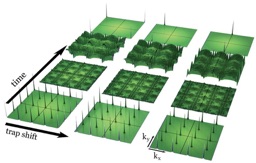
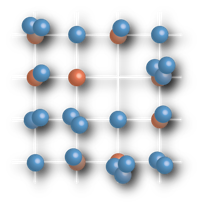
NOVEMBER 10, 2011
Successful Defense of my PhD Thesis!
Today I successfully defended my thesis „Interacting bosons and fermions in three-dimensional optical lattice potentials - From atom optics to quantum simulation“ at the University of Mainz with summa cum laude :)
My colleagues at LMU Munich have built a wonderful doctoral hat („Doktorhut“) for me. It has been so moving. Thank you so much, guys!
The orange LED show on top of the hat imitates the collapse and revival quantum dynamics of bosonic atoms in an optical lattice (see the bottom of this page). It is absolutely fantastic!
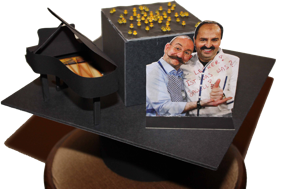
MAY 9, 2012
Pioneering Studies of a New Quantum Gas Mixture: Sodium-Potassium
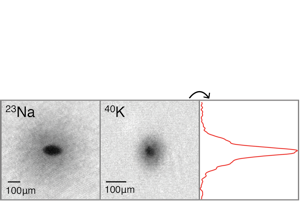
With our experimental setup at MIT, we have performed pioneering studies with a new mixture of ultracold quantum gases: For the first time Sodium (Na) and Potassium (K) have been cooled down simultaneously to temperatures very close to absolute zero - see pictures on the left side.
In this work we have also performed the first studies on the interactions between Na and K. The strength of their interactions can be tuned by exceptionally nice Feshbach resonances. Simply by exposing the atomic clouds to homogeous fields around 100 Gauss their interactions can be tuned freely!
Jee Woo Park, Cheng-Hsun Wu, Ibon Santiago, Tobias G. Tiecke, Sebastian Will, Peyman Ahmadi, and Martin W. Zwierlein
„Quantum degenerate Bose-Fermi mixture of chemically different atomic species with widely tunable interactions“
AUGUST 20, 2012
Creation of the First Ultracold 23Na40K Molecules

Cheng-Hsun Wu, Jee Woo Park, Peyman Ahmadi, Sebastian Will, and Martin W. Zwierlein
„Ultracold Fermionic Feshbach Molecules of 23Na40K“
Physical Review Letters 109, 085301 (2012) or arXiv:1206.5023
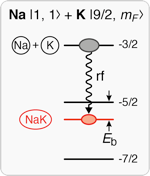
We have successfully created the first ultracold molecules of sodium and potassium: 23Na40K. These molecules have a temperature of only 500 nanoKelvin and the atoms constituting the molecule are extremely weakly bound. Despite the very small binding energy, we observe that our NaK molecules live surprisingly long having lifetimes of up to 100 ms or more.
The first weakly bound NaK molecules that we created here, pave the way to the creation of ultracold strongly bound NaK molecules. Such strongly bound NaK molecules will have amazing properties. Most importantly they will feature long-range dipolar interactions. With such long-range interactions we might be able to create a quantum system, in which quantum particles can interact with each other even if they are very far apart from each other!
Our paper got special recognition by the Editor‘s at Physical Review Letters, earning an „Editor‘s Suggestion“...
JANUARY 13, 2013
PhD Thesis Published by Springer Publishing House
My PhD thesis „From Atom Optics to Quantum Simulation - Interacting Bosons and Fermions in 3D Optical Lattice Potentials“ just appeared at Springer publishing house. It is beautifully typeset and a lot of fun to read!
Thank you very much to all the people who made this possible!
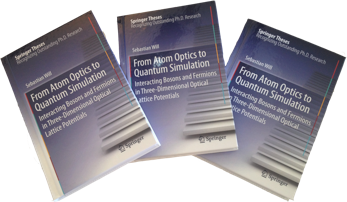
Sebastian Will
„From Atom Optics to Quantum Simulation -
Interacting Bosons and Fermions in Three-Dimensional Optical Lattice Potentials“
ISBN 978-3-642-33632, Accessible online at SpringerLink or available at Springer and Amazon
DECEMBER 10, 2012
Physics Nobel Prize 2012 Awarded to Dave Wineland and Serge Haroche
This years Noble Prize in physics goes to two giants of atomic physics, Dave Wineland (NIST Boulder) and Serge Haroche (ENS Paris)! They are masters of experimental physics bringing bold Gedanken-experiments into reality; their works opened our eyes for many subtleties of the quantum world.
One of Serge Haroche‘s experiments, the collapse and revival of a photon field, inspired one of the experiments that I did during graduate school, observing the collapse and revival of an atomic matter wave field. These experiments show that the dynamics of photons and atoms can be very similar!


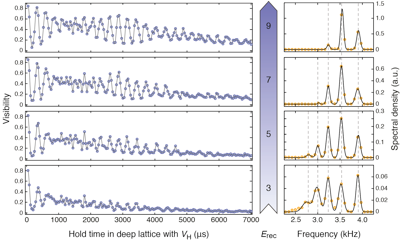
Atoms:
Photons:









DECEMBER 24, 2013
The Infinite Kilometer (K) Award
Very happy about receiving “The Infinite Kilometer (K) award” from the MIT School of Science :)


JANUARY 01, 2013
Conducting a Quantum Orchestra
My article “Conducting a Quantum Orchestra” has appeared in the Journal of Unsolved Questions as part of a special issue on scientific labor. Learn about our particular working style and what’s actually going on, when we cool atoms to absolute zero temperature in the lab...

SEPTEMBER 22, 2014
Coherent Quench Dynamics in Metallic States of Fermionic Atoms
Ultracold fermionic atoms in an optical lattice are a near-ideal, almost perfectly controllable quantum system that allows to study the behavior of electrons that determines the properties of modern materials, such as superconductors or magnetic materials. However, it is even possible to go a step beyond and study nonequilibrium dynamics of fermionic atoms in an optical lattice - something that is not easily possible in real materials. By performing a quench that abruptly switches on the interactions between the fermions, we - so to speak - set the system into a “quantum motion”. We watch how it coherently evolves under the influence of the interaction, entirely following the laws of quantum mechanics.
The first experimental observation of coherent quench dynamics with fermions is reported here...
Sebastian Will, Deepak Iyer, Marcos Rigol
„Observation of coherent quench dynamics in a metallic many-body state of fermionic atoms“
Nature Communications 6:6009 (2015) and arXiv:1406.2669 (2014)
...which lead us to an in-depth theoretical study of such dynamics in fermionic Hubbard models:
Deepak Iyer, Rubem Mondaini, Sebastian Will, Marcos Rigol
„Coherent quench dynamics in the one-dimensional Fermi-Hubbard model“
Phys. Rev. A 90, 031602(R) (2014) and arXiv:1408.1700 (2014)
Ultracold fermionic atoms in an optical lattice are a near-ideal, almost perfectly controllable quantum system that allows to study the behavior of electrons that determines the properties of modern materials, such as superconductors or magnetic materials.


MAY 18, 2015
First Creation of a Dipolar Gas of Ultracold NaK Molecules
We have published our results on the first creation of a dipolar gas of ultracold Sodium-Potassium (NaK) molecules in the absolute ground state.

Jee Woo Park, Sebastian A. Will, and Martin W. Zwierlein
“Ultracold Dipolar Gas of Fermionic 23Na40K Molecules in Their Absolute Ground State”
Phys. Rev. Lett. 114, 205302 (2015) and arXiv:1505.00473
Accompanied by a Physics Synopsis
The creation of dipolar NaK molecules is detailed in this paper:
Jee Woo Park, Sebastian A. Will, and Martin W. Zwierlein
“Two-Photon Pathway to Ultracold Ground State Molecules of 23Na40K”
Extensive media coverage:
-
• Huffington Post: “Scientists Create World’s Coldest Molecules Ever”
-
• Scientific American: “Molecules Reach Coldest Temperature Ever”
-
• GIZMODO: “Physicists Just Cooled Molecules to a Hair Above Absolute Zero”
-
• Yahoo News: “Molecules Reach Coldest Temperature Ever”
-
• Tech Times: “Potassium Molecules Cooled To Nearly Absolute Zero Exhibit Strange Behavior”
-
• phys.org: “At near absolute zero, molecules may start to exhibit exotic states of matter”
-
• MIT News: “MIT team creates ultracold molecules”
-
• pro-physik.de: “Natrium-Kalium-Moleküle: eiskalt polarisiert”
APRIL 04, 2016
NaK Molecules Brought to the Next Rotational Level
We have transferred ultracold dipolar NaK molecules to the first excited rotational level and observe a long lifetime of about 3 seconds! This work opens new routes for the use of ultracold molecules for quantum simulation and quantum information processing.
Sebastian A. Will, Jee Woo Park, Zoe Z. Yan, Huanqian Loh,
and Martin Zwierlein
“Coherent Microwave Control of Ultracold 23Na40K Molecules”
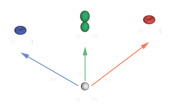

See also the great viewpoint article by Susanne Yelin:
“Taming Ultracold Molecules”






Will Lab at Columbia University in the City of New York

Are you interested in exploring the new world of ultracold dipolar molecules? We have openings for
-
• graduate research assistants
-
• undergraduate research assistants
-
• postdoctoral associates
Currently, we are accepting applications for the Earnest Kempton Adams Postdoctoral Fellowship. To submit your application or for more information on the projects, don’t hesitate to send a message:


JUNE 14, 2016
Second-Scale Coherence Time in Ultracold NaK Molecules
Can dipolar molecules be used for quantum computing? A physical system with ideal properties for quantum computing, on the one hand, can store a quantum bit for a long time. On the other hand, it should allow for switchable interactions between quantum bits to realize quantum gate operations. This combination of features is rare to find.
We show that ultracold NaK molecules can serve as a storage medium for quantum information. We observe coherence times on the second-scale, comparing favorably to other physical systems. Utilizing dipolar interactions, ultracold molecules will not only allow the storage of quantum bits, but also the processing of quantum information in molecular quantum gates.
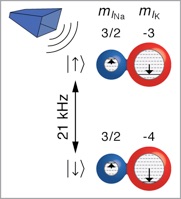
Jee Woo Park, Zoe Z. Yan, Huanqian Loh, Sebastian A. Will,
and Martin Zwierlein
“Second-Scale Nuclear Spin Coherence Time of Trapped Ultracold 23Na40K Molecules”



FEBRUARY 21, 2017
Sebastian Will receives 2017 Sloan Research Fellowship
Sebastian has been selected as one of this years Sloan Research Fellows in Physics. Awardees were just announced in the New York Times. For more details see:

MARCH 16, 2017
Group Website
Our group website www.will-lab.com will be online soon. Stay tuned!
